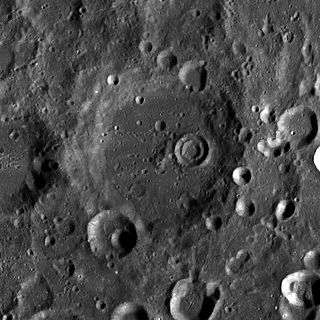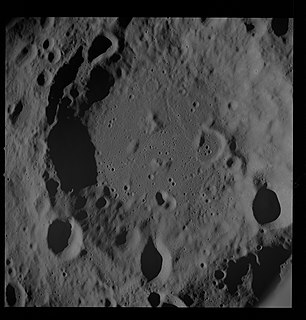
Cantor is a lunar impact crater that is located on the northern hemisphere on the far side of the Moon. The outer rim of the crater has a distinctly hexagonal shape, and is slightly longer in the north–south direction. The interior walls are multiply terraced, although less so along the western rim. There is a low central peak at the midpoint of the floor.

Bartels is a lunar impact crater located along the western perimeter of the Moon's visible face. At this location the crater is viewed from the side, and visibility is affected by libration. The crater can be viewed in its entirety only from lunar orbit. It is located to the north of the crater Moseley and south-southeast of Voskresenskiy.

Barocius is an ancient lunar impact crater that is located in the rugged southern highlands of the Moon. It was named after Italian mathematician Francesco Barozzi. It lies just to the southeast of the large crater Maurolycus. To the southwest of Barocius is Clairaut, and to the south-southeast lies Breislak.

Appleton is a heavily eroded lunar impact crater that lies in the northern hemisphere on the far side of the Moon. To the northwest are the craters Von Neumann and Campbel. The smaller Golovin lies to the northeast, while further to the southwest is the Mare Moscoviense.

Doerfel is a lunar impact crater that is located in the vicinity of the southern pole, just on the far side of the Moon. It lies approximately midway between the large crater Hausen to the east-northeast and the even larger Zeeman to the southwest.

Büsching is a lunar impact crater that is located in the crater-covered southern highlands of the Moon. It was named after German geographer Anton F. Büsching. The similar-sized crater Buch is located adjacent to its southwestern rim, and further to the southwest lies Maurolycus.

Bell is a lunar impact crater that is located on the far side of the Moon, just past the western limb. It lies in an area of terrain that is marked by many small craters, a number of which are satellite craters of Bell listed in the table below. Bell lies within two crater diameters of Laue to the north, and to the west of the smaller Helberg.

Barbier is a lunar impact crater that is located on the southern hemisphere on the far side of the Moon. It forms a matched pair with Cyrano to the north-northwest, and it lies to the southeast of the huge walled plain Gagarin. Southwest of Barbier is the crater Sierpinski, and to the southeast is the Mare Ingenii.

Beijerinck is a lunar impact crater on the far side of the Moon. It lies to the south of the larger crater Chaplygin, and to the northeast of the huge walled plain Gagarin.

Birkeland is a lunar impact crater that lies in the southern hemisphere on the far side of the Moon. This crater is attached to the central waist of the oddly shaped Van de Graaff crater formation, and may partly account for that crater's figure-8 shape. To the southeast is the large walled plain Leibnitz.

Coriolis is a lunar impact crater that is located on the far side of the Moon. The crater floor is bisected by the lunar equator, and it lies about three crater diameters northwest of the crater Daedalus.

Chandler is a lunar impact crater in the northern hemisphere, on the Moon's far side. It lies to the southeast of the large walled plain D'Alembert, and southeast of the slightly smaller Chernyshev crater.

Chaplygin is a large lunar impact crater that lies on the far side of the Moon. It is located to the southeast of the huge walled plain Mendeleev, about midway between the craters Schliemann to the northeast and Marconi to the southwest. It is about the same size as Albategnius on the near side.

Comrie is a lunar impact crater. It is located on the rugged far side of the Moon relative to the Earth, beyond the western limb. Nearby craters of note include Ohm to the south-southwest, Shternberg to the southwest, and Parenago to the northeast.

Cockcroft is a lunar impact crater that is situated on the far side of the Moon from the Earth, so that it has only been observed and photographed from orbit. It lies to the northeast of the larger crater Fitzgerald, and southeast of Evershed.

Faye is a heavily eroded lunar impact crater in the rugged southern highlands of the Moon. It is named after French astronomer Hervé Faye. It is attached to the northeastern rim of the crater Delaunay, with Donati located just a few kilometers to the northeast. It forms part of a chain of craters of increasing size to the southwest that continues with La Caille and ends with the walled plain Purbach.

Fourier is a lunar impact crater that is located in the southwestern part of the Moon's near side, just to the southeast of the crater Vieta. To the northeast is the Mare Humorum. The rim of this crater is roughly circular, but appears oval when viewed from the Earth due to foreshortening.

De Vries is a lunar impact crater on the far side of the Moon relative to the Earth. It lies about midway between the craters Racah to the north-northwest and Orlov to the south-southeast. An nameless walled plain lies between De Vries and Orlov, with the perimeter of this feature joining the two rims.

Dellinger is a lunar impact crater that is located on the Moon's far side. It is attached to the southern rim of the crater Pannekoek. To the southeast lies the crater Marconi, and to the southwest is Chauvenet.

Fleming is a large lunar impact crater that is located on the Moon's far side, and cannot be seen from the Earth. It lies about a crater diameter to the east-northeast of Hertz, and to the northwest of Lobachevskiy.























